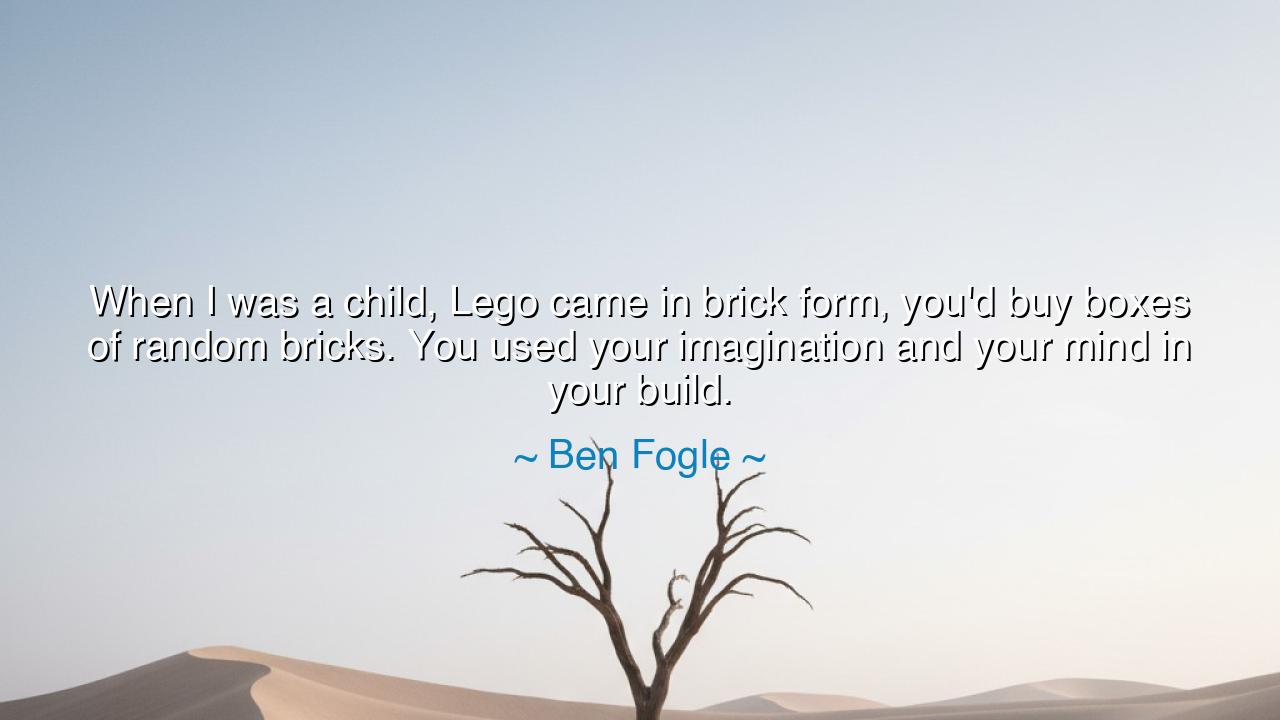
When I was a child, Lego came in brick form, you'd buy boxes of
When I was a child, Lego came in brick form, you'd buy boxes of random bricks. You used your imagination and your mind in your build.






“When I was a child, Lego came in brick form, you'd buy boxes of random bricks. You used your imagination and your mind in your build,” said Ben Fogle, the adventurer and storyteller whose life has been shaped by curiosity, resilience, and wonder. His reflection reaches beyond childhood play; it speaks to the spirit of creativity that built civilizations long before instruction manuals existed. In this simple memory of colored bricks and youthful dreams, Fogle offers a quiet lament for a world that has traded imagination for direction, and freedom for prescription. His words are a call to return to the sacred art of creation — to once again build, not from templates, but from the raw materials of the mind.
In the age of his childhood, a box of Lego was a box of infinite potential. There were no blueprints, no rigid steps to follow, no preordained outcome waiting to be assembled. Each child became a creator, shaping castles, ships, and cities not yet imagined by any company or designer. From a handful of random bricks arose whole worlds — worlds born of instinct, curiosity, and intuition. To build with imagination was to engage in a kind of meditation, where trial and error were teachers, and mistakes became stepping-stones toward beauty. The child learned not only to create, but to think, to persevere, to envision.
Fogle contrasts this with the modern trend — where each box comes with fixed pieces, numbered bags, and glossy pictures of what the final structure must be. It is efficient, yes, but the freedom of creation has been replaced by the comfort of conformity. The builder becomes a follower, not an inventor. The imagination, once wild and untamed, is guided into a narrow lane. And so, the joy of discovery fades into the satisfaction of completion. What was once a blank canvas has become a checklist. The spirit of play, once sacred to human growth, now bows to the cult of perfection.
But this transformation, Fogle’s words imply, is not confined to toys. It is the mirror of a greater change in the human condition. We live now in an age of templates — of pre-written dreams and mass-produced identities. The world offers us endless instructions on how to live, how to succeed, how to love, even how to think. Yet in following these, we risk losing the inner voice that once whispered, “Imagine.” Just as the child now builds only what the box commands, so too does the adult build only what society approves. The imagination, once humanity’s greatest instrument of discovery, begins to rust from disuse.
History, however, belongs to those who dared to build without instructions. Leonardo da Vinci sketched flying machines when there were no skies to navigate. The Wright brothers, armed with scrap wood and persistence, constructed the first airplane from intuition and trial. Marie Curie delved into the unseen, discovering elements no eye had beheld before. None of these souls followed numbered steps. They held, instead, the spirit of the child with a box of random bricks — guided not by certainty, but by wonder. Their greatness was born from imagination unbound, from the courage to make something that did not yet exist.
Thus, Fogle’s reflection is not nostalgia alone — it is instruction. He reminds us that imagination is the foundation of all true creation. It is the muscle of the mind that must be exercised, or it will grow weak. Whether you build with bricks, with words, with ideas, or with dreams, begin not with the finished picture, but with the question: What if? For it is in the unknown — in the chaos of loose pieces and open possibility — that the mind awakens to its greatest power.
Let this be the lesson to pass down: do not be afraid to build without instructions. Embrace the random bricks of life — the uncertain, the imperfect, the unplanned. Use your mind and your imagination to shape them into something that bears your mark. In doing so, you will rediscover the creative joy that built the pyramids, painted the frescoes, and composed the symphonies. For every masterpiece begins as a handful of fragments — and it is only through courage and imagination that the builder gives them form.
And remember, as Ben Fogle teaches, the truest building does not occur with the hands, but with the heart and the imagination. To create is to reclaim the birthright of humanity — the power to turn nothing into something, to see beyond the given, and to breathe life into the unseen. So take up your bricks — whatever they may be — and build not the world that is pictured on the box, but the one that only you can see.






AAdministratorAdministrator
Welcome, honored guests. Please leave a comment, we will respond soon